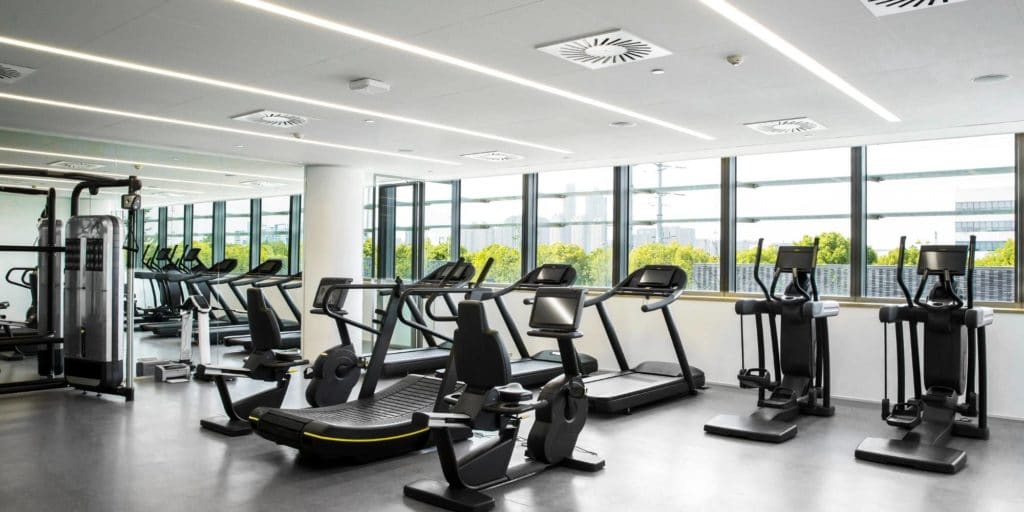As a personal trainer, you’re used to spending a lot of time in the gym and see it as a place of peace and comfort. However, many people have a fear of the gym. People have gym fear for a number of different reasons and can see it as an intimidating environment.
Reasons your clients might have a fear of the gym
- Lack of experience or knowledge
- Negative previous experiences
- Worried about other people being around
- Lack of body confidence
- Facility cleanliness concerns
It’s important to do what you can to help them overcome this fear. We’ll cover how to get your clients over gym fear and how to help the gym-conscious client feel motivated to work out.

Top tips for helping your clients overcome the fear of the gym
#1 – Meet up outside the gym first
If your client is scared to go to the gym, suggest that you meet outside first. As a personal trainer, you should have your own collection of weights and resistance bands, even if just for your gym-scared clients.
Or, for your first practice, you and your client could just focus on bodyweight exercises.
Depending on the current restrictions in place in your country of operation, entering their house might not be an option. If the weather allows, meet online or head to the local park!
Check out these 5 Easy Outdoor Training Ideas if you need some inspiration!
When you meet, talk about the gym in a positive light, and maybe gently suggest that you take your client on a tour around the gym when possible.
This will also consider why they’re afraid of the gym. Some reasons will mean they might not ever be comfortable in the gym. Helping clients with gym fear does not mean helping them go to the gym, it means helping them work out in their way.
This could be a time to consider video or social media forms of workouts and helping. This may also help clients get used to watching you in the gym and feel like they are more comfortable after watching you there.
#2 – Show them around and be patient with their gym fear
Don’t plan on doing any exercises the first time your client goes into the gym unless they are feeling up to it.
Be patient with your clients, as everyone is different and some people will take longer than others to feel comfortable. Gym fear looks different on everyone, and helping with gym fear is a different process for everyone as well.
If they give the go-ahead to go to the gym, take them on a tour. Explain the machines as well as the various weights that they could use.
Make sure that they know what ‘sets’, ‘reps’ and other gym language means if you haven’t gone through these on your sessions already. Making a gym seem as welcoming, comfortable and familiar as possible.
Then, ask them if they feel comfortable working out here. Getting over gym fear could be as simple as introducing them to the space, or it might not – keep being persistent if your client is still giving signals of wanting to go to the gym, help them on their way.
Ensure you’ll supervise them throughout and use comforting language. But whatever you do, don’t make a spectacle of them!

#3 – Choose a quiet time
Many people are scared of gyms because they don’t like the idea of other people watching them work out.
If your client is scared to go to the gym, even if it isn’t due to crowds watching, this would be a good option – would be easier for you as well, to make the showing smoother.
Bearing this in mind, suggest that your first gym session be when it is quietest. This will need to fit around your client’s schedule of course, but it could be in the middle of the day when most people are at work, or very early in the morning.
Typically, avoid evenings and weekends when your client is getting used to working out in a gym environment.
#4 – Stick with a simple programme
If your client has gym fear and agrees to a trial in the gym, make sure that the client has already done all of these exercises outside the gym. Then, if they haven’t had the chance to do that, send them information on the exercises and maybe some visual examples ahead of the next session.
If you want to challenge them, you could just add a bit of extra weight onto their exercise.
For example, they could do squats with dumbbells rather than just with bodyweight. Make sure that they have plenty of space, and aren’t too close to anyone using bodybuilding-level weights.
With just a bit of time, your client should overcome their gym fear and will see why you love it so much!